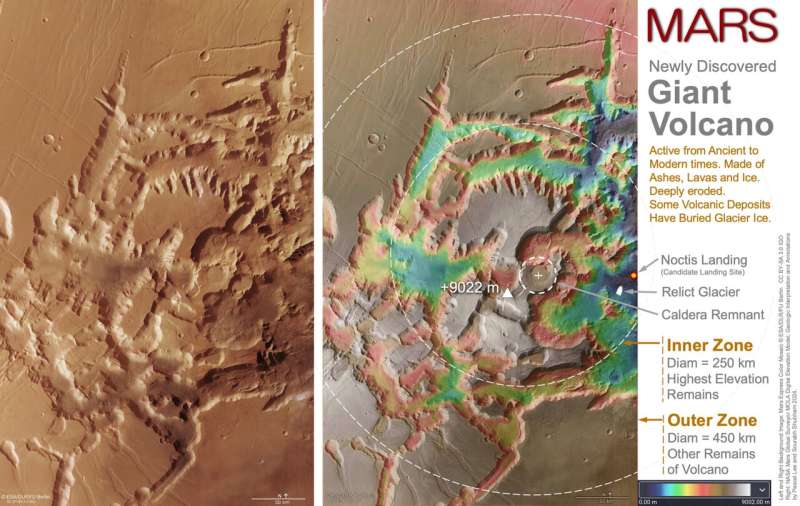March 16, 2024 report
This article has been reviewed according to Science X's editorial process and policies. Editors have highlighted the following attributes while ensuring the content's credibility:
fact-checked
trusted source
proofread
Saturday Citations: The volcanoes of Mars; Starship launched; 'Try our new menu item,' say Australian researchers

You never can tell when planetary scientists are going to discover a new giant volcano on Mars, but when it happens, I step out to the porch and raise my Lunar and Planetary Society Core-Mantle Boundary Rift Discovery flag so all the neighbors will know, and this week, that flag was flapping in the breeze.
SpaceX successfully launched a big rocket; scientific volunteers played with dogs—for science!—and Australian researchers made a slightly diffident gesture toward a possible new source of protein that may just constrict you until you suffocate.
Volcano furtive
At the 55th Lunar and Planetary Conference this month, scientists announced the discovery of a giant volcano and a possible sheet of buried glacier ice near the Mars equator. The volcano, like Keyser Söze, has been "hiding in plain sight for decades," but the region is so eroded that the volcano has been overlooked in orbital imagery taken since the 1970s.
Among the geological clues that identified the region as a sprawling volcano were a series of elevated mesas forming an arc. A caldera remnant is clearly visible in the center of the structure, and the researchers identified the scars of lava flows and hydrated mineral deposits around the perimeter of the site.
Obviously, research attention is now focused on future robotic exploratory missions to the region, as it further illuminates the history of Mars geology and the process of glaciation that changed the features of the planet.
Rocket semi-validated
This week, SpaceX successfully launched Starship, the world's most powerful rocket that will never travel to a star, to an altitude of 200 kilometers above sea level. The vehicle made half an orbit of the earth before an unsuccessful descent and vessel loss over the Indian Ocean.
But credit where it's due: The retrieval of rockets after launch is a titanic engineering challenge that has only ever been met by SpaceX with its Falcon 9 and Falcon Heavy launch vehicles. Following the launch, on X, formerly Twitter, SpaceX CEO Elon Musk posted, "Starship will make life multiplanetary."
This was the third attempt at the launch of the massive rocket; during the first attempt in April 2023, SpaceX aborted and destroyed the rocket a few minutes after launch when its two stages failed to separate.
In a November 2023 test, the booster did separate, but both stages exploded over the ocean in what the Victorians would describe as an "expeditive unanticipated disaggregation." The roadmap for Starship doesn't get any easier: SpaceX still needs to test its Starship tankers, which will launch into orbit to refuel a Starship for missions to the moon and Mars.
Protein yummy
Depending on the month, researchers insist that humans of the future will subsist on krill, seaweed, insects, and cultivated fungi. Now, Australian study slots pythons into the Venn diagram of possible future foods, intersecting with "currently considered unappetizing depending on your cultural milieu," "capable of constricting you to death," "scary" and "likely to be rejected by vegans."
However, researchers from Macquarie University found that farmed pythons convert feed into body mass more efficiently than chickens and cattle. "In terms of food and protein conversion ratios, pythons outperform all mainstream agricultural species studied to date," says Dr. Daniel Natusch from the School of Natural Sciences. Snake meat is high in protein and, I assume, tastes like chicken in accordance with the effects of unusual foods on human taste receptors.
Whatever that chicken receptor is—glutamate?—it's really easy to activate. We've all seen "The Matrix"; we know this. Anyway, the study was based on a comparison of reticulated pythons and Burmese pythons at commercial python farms in Thailand and Vietnam, which I bring up because I've lived for decades ignorant of the existence of python farms.
Boy good
Researchers at Konkuk University in South Korea report that hugging dogs has beneficial effects on human stress, concentration and relaxation, to which I would add "after the age of three." (Between four months and three years, the effect of a dog on human stress is like the effect of a pressurized flame accelerant on a backyard fire pit.)
Because previous studies focused primarily on holistic effects, the South Korean researchers designed one that differentiates between types of interactions, including feeding, playing, and grooming. Thirty adult participants interacted with trained dogs over the course of the study while wearing EEG electrodes to record brain electrical activity.
They report that alpha-band oscillations in the brains of humans during walking and playing interactions indicate an effect on a state of relaxed wakefulness. Other activities like grooming or petting dogs increased beta-band oscillation strength, to which they attribute heightened concentration. In general, the volunteers reported decreases in stress and fatigue after interacting with dogs.
© 2024 Science X Network




















